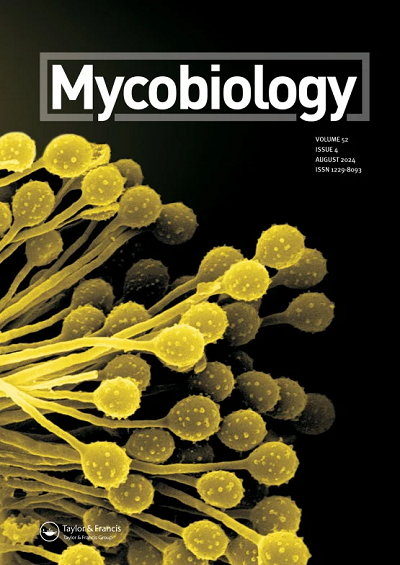与韩国香甲虫有关的八种真菌。
IF 2
4区 生物学
Q2 AGRONOMY
引用次数: 0
摘要
食腐菌因其与食腐甲虫的共生作用而闻名,食腐菌是食腐甲虫幼虫和成虫的唯一食物来源。作为揭示这些相互作用的第一步,对居住在韩国的神仙甲虫的真菌共生体进行了广泛的调查。从15种神仙甲虫中分离出的8种真菌在韩国尚未发现。其中7个分属子囊菌门2目;微孢子菌(beaveri Ambrosiella, catenulate A., roeperi)和蛇口菌(Leptographium verrucosum, Raffaelea cyclorhipidii, rfusca和eucastansporothrie)和担子菌门(Irpex subulatus)的多孢子菌。这是国内首次报道该种并附有分类描述。本文章由计算机程序翻译,如有差异,请以英文原文为准。
Eight Fungal Species Associated with Ambrosia Beetles in Korea.
Ambrosia fungi are well-known for their symbiotic interactions with ambrosia beetles, acting as a sole food source of larvae and adult beetles. As a first step to reveal these interactions, extensive survey on the fungal symbionts of ambrosia beetles dwelling in Korea. Eight fungal species isolated from 15 ambrosia beetle species were not known for their presence in Korea. Seven of these belonged to two orders of Ascomycota; Microascales (Ambrosiella beaveri, A. catenulate, and A. roeperi) and Ophiostomatales (Leptographium verrucosum, Raffaelea cyclorhipidii, R. subfusca, and Sporothrix eucastaneae) and one to Polyporales of Basidiomycota (Irpex subulatus). This is the first report of these species in Korea with taxonomic descriptions.
求助全文
通过发布文献求助,成功后即可免费获取论文全文。
去求助
来源期刊

Mycobiology
AGRONOMYMYCOLOGY-MYCOLOGY
CiteScore
3.90
自引率
5.30%
发文量
41
审稿时长
22 weeks
期刊介绍:
Mycobiology is an international journal devoted to the publication of fundamental and applied investigations on all aspects of mycology and their traditional allies. It is published quarterly and is the official publication of the Korean Society of Mycology. Mycobiology publishes reports of basic research on fungi and fungus-like organisms, including yeasts, filamentous fungi, lichen fungi, oomycetes, moulds, and mushroom. Topics also include molecular and cellular biology, biochemistry, metabolism, developmental biology, environmental mycology, evolution, ecology, taxonomy and systematics, genetics/genomics, fungal pathogen and disease control, physiology, and industrial biotechnology using fungi.
 求助内容:
求助内容: 应助结果提醒方式:
应助结果提醒方式:


